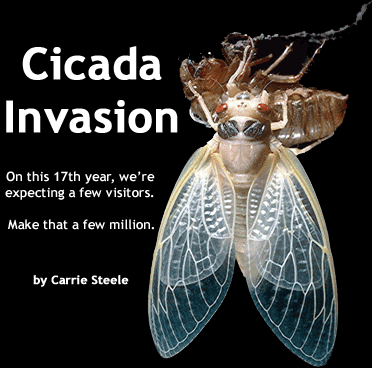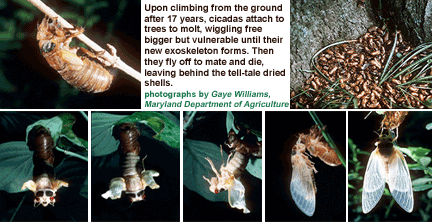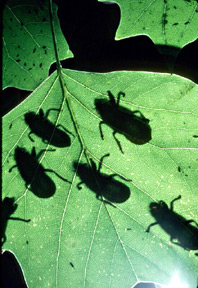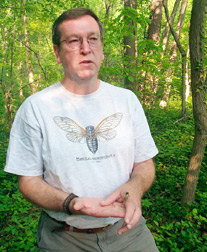|
 When it comes to cicadas, you’re likely to fall into one of two categories. You either dread the imminent cicada explosion, picturing millions of nymphs rising from the midnight earth like a 1950s’ horror film. Or you embrace our cicada year with curiosity, eager to get to know these winged creatures that visit only once every 17 years. When it comes to cicadas, you’re likely to fall into one of two categories. You either dread the imminent cicada explosion, picturing millions of nymphs rising from the midnight earth like a 1950s’ horror film. Or you embrace our cicada year with curiosity, eager to get to know these winged creatures that visit only once every 17 years.
If you’re in the former category, you’ve probably bought bug-proof netting for your shrubs, postponed all garden parties and arranged to stay inside for most of May and June. But if you’re the latter, you may have already checked out some of the 3,000-plus cicada websites and watched for the first small holes appearing in the ground.
Lloyd Tydings is certainly of the second sort.
A naturalist and amateur entomologist at Carrie Murray Nature Center in Baltimore, Tydings affirms affinity for insects. “I just happen to like bugs,” says Tydings.
Working at the nature center, Tydings has seen all sorts of reactions to the impending cicada invasion.
“People are afraid of bugs in general,” says Tydings. “Some people tend to overreact.” By overreacting, Tydings means not only leaving town but leaving the country while the 17-year cicadas surface.
If you’re planning to flee, you’d better go soon. Earliest cicadas started trading in their underground dwellings in favor of our outside world as May’s moon filled out last week. The full resurrection is expected when the soil temperature half a foot down hits 64 degrees, which should happen around May 15.
Much of Chesapeake Country is expected to be invaded. St. Mary’s County, however, is likely to miss the emergence, as cicadas were few there 17 years ago. Still, it’s bigger than we are. Five neighboring plus 10 Midwestern and Southern states are also bracing. As Chesapeake Country prepares for the invasion, Tydings has been busy. “We’ve been cicada central at our center. I get 10 or 12 cicada calls a day,” he says.
Life as a Cicada
In a plastic shoebox, Tydings carries a sneak preview: a few nymphs plus a comforting inch of soil. When we meet at Barnes & Noble Booksellers, he uncovers the box and pulls one nymph out. Cradled in his hand, it works its curved front legs to move backwards, as if it could tunnel down, away from the limelight that has drenched these insects this spring.
About one and a half inches long, cicadas have rice-paper-thin wings, red eyes and gripping pinchers on the front walking pair of their six insect legs.
Seventeen summers ago, while Ronald Reagan was president and The Cosbys still aired on prime-time television, tiny cicada nymphs the size of a small-case letter fell to the ground from trees and almost anything else their parents could cling to. Digging deep tunnels with their front legs, they submerged themselves 12 to 18 inches deep. Protected in Mother Earth, the nymphs made their way to tree roots, where they’ve been hiding out since, feeding on the roots and growing ever so slowly.
Now, 17 years later, these cicadas are tunneling out of their tree-root nurseries. As they push their way up, turrets of soil displaced in the cicadas’ wake mark their activity.
Mid-May on a warm night, you can — if you’re the curious sort — go out with a flashlight and see them sitting on top of their mud turrets, as if surveying the land for the first time before they make a final molt into adulthood and cicada chaos. Making their grand entrance after sunset protects them from predators.
When the cicadas fully emerge, they’ll creep toward the first vertical object they find, usually a tree. “They’re kind of like little robots,” says Tydings.
Once the cicadas find a perch, they molt into their final adult stage, breaking out of their outer shell, which slits to free them. They leave behind their empty shells, brown and brittle, for you to find.
“When these guys molt,” Tydings explains, “They’ll get wings, two little dots on the backs of their heads and bright red eyes.”

The newly molted cicadas cling to their perch until their spiffy new black-bodied, orange-winged exoskeleton dries; then they take flight.
Finally adults, cicadas have one goal: to reproduce. “They have a one track mind: ‘we’ve gotta breed,’” says Tydings. “It’s like one big singles party when the bar’s closing.”
That cacophonous humming or buzzing that makes male cicadas so famously noisy is a siren song to attract females.
Cicada buzzing is not a vocal call, however. It comes from the male’s abdomen, where a muscle flexes and releases up to 600 times a second, creating a vibration between two hollow abdominal chambers. All this is amplified to the screech we know and female cicadas love.
Once the sexes have found one another, the female works its ovipositors to carve slit after slit into the branches where to deposit her cache of hundreds of eggs. The male seeks other partners in the short days before both sexes expire.
In spots where the emergence was thick, their bodies may pile up inches deep, crunching under your feet. Yet another reason you may wish to stay inside if cicadas give you the creeps.
Six weeks later, tiny new cicada nymphs resembling translucent grains of rice hatch, and the 17-year cycle starts all over again. The nymphs will dig their way to the roots of a tree, where they’ll find years of nourishment. During those years underground, cicadas store up fat that will carry them through their brief but active adult stage.
Nuisance or Novel Neighbor?
If you’re a curious amateur naturalist — and no hesitant hideaway — this is your time to get to know cicadas. You’ll do more than merely see them. Your senses will encounter the whole invasion. You’ll hear the incessant buzz of the insect that holds the loudness record in the University of Florida’s Book of Insect Records. Their volume — nearly 107 decibels — approaches the 110 decibels of a chainsaw. You’ll touch their molted shells and perhaps even taste them in a stir-fry — if you’re brave or very hungry.
This is one of the largest insect invasions in the world, with numbers throughout 16 states climbing into billions, perhaps even in the trillions, so you’re in for a spectacular event.
On the other hand, if you’re one of those cicada-apprehensive individuals, you’ve been hiding inside, nourishing your misapprehensions and avoiding the whole show.
Some of your fears have been old wives’ tales, Tydings said.
 “They’re not after flowers and vegetable gardens,” says Tydings. Cicadas don’t even damage larger trees. Flagging — caused as female cicadas carve a slit into a branch to lay their eggs — sometimes stops the flow of nutrients to that branch tip. Mostly, says Tydings, that’s a natural pruning process that shouldn’t hurt the tree — though he allows that flagging might set back new trees. “They’re not after flowers and vegetable gardens,” says Tydings. Cicadas don’t even damage larger trees. Flagging — caused as female cicadas carve a slit into a branch to lay their eggs — sometimes stops the flow of nutrients to that branch tip. Mostly, says Tydings, that’s a natural pruning process that shouldn’t hurt the tree — though he allows that flagging might set back new trees.
Nor are cicadas after you. They neither bite nor sting.
But even Tydings admits that their sheer numbers will make the insects impossible to ignore.
“These guys are very good fliers,” says Tydings. Cicadas can fly for up to nine hours without a break. What they have in endurance, however, they lack in agility. Cicadas are notoriously clumsy fliers, which means they may bump into people. Or cars.
“People will need to buy gallons of windshield wiper fluid,” suggests Tydings. “It can be some serious bug glue.”
Sure you can think of cicadas as gooey nuisances. But by so thinking, you’re missing out on a rare opportunity. This cicada invasion is a phenomenon that we’re able to experience only four or five times in our lifetime. Better to think of them as visiting guests.
Counting on Company
How many cicadas can you expect to come visiting?
It depends on where you live. “In heavy emergence areas, I’ve heard up to a million per acre,” says Tydings. “It depends on how well they bred in 1987. They don’t move around a whole lot, so if the area was heavy in 1987, then it will likely be heavy this year.”
Undisturbed mature hardwood tree stands and established woodlands will see the most cicadas. Paved areas and freshly plowed areas may see the least. “If there’s been a lot of development recently or disturbance in the soil, there may not be many,” says Tydings.
Like visitors who come calling, not all cicadas are alike. Maryland’s visitors are brood 10. Worldwide, 17-year cicadas have spread into about 15 broods. Of those, the largest is brood 10, extending from Maryland and New Jersey to Indiana and as far south as Georgia. Some broods of the 17-year cicada haven’t been seen for well more than 17 years and could be extinct, done in by some unknown environmental factor, localized development or even extreme cold.
Seventeen-year cicadas have evolved into three, and perhaps four, different species. Brood 10 includes all three species, and you might have all three in your back yard. The cicadas look so similar, though, you have to be an entomologist to tell them apart. Most common are the big ones.
An estimated 13 to 15 different kinds of cicadas thrive in Maryland, each with its own mating call or sound, but the 17-year is the only species that emerges in spectacular numbers.
Another type of cicada, the 13-year cicada, emerges more often, but never with the fanfare of their older relatives. The 13-year are never as numerous as the 17-year.
Nor should you confuse your cicada with the dogday harvestfly, an annual cicada that comes out in the dogdays of summer. The 17-year cicadas will definitely overshadow them, according to Tydings. But brood 10 will be gone by the end of June, when annual cicadas come out to screech their own sizzling mating call.
Other Insect Plagues
Cicadas are not locusts, which are actually winged grasshoppers that can fly. That’s a fact cicada-worriers can be glad of.
The Biblical plagues of winged insects were locusts, which differ from cicadas in their voracious appetites. Cicadas store up their calories underground. Locusts, on the other hand, eat anything in their path.
In locust plagues ancient and modern, grasshoppers chow down. To appear in plague numbers, locusts (or other insects) need to have the rain to produce the grasses and other food sources.
While 17-year cicadas do not plague Chesapeake Country in this way, nationwide other insects have a mission to populate. The Mormon crickets of Utah and Nevada, an annual cicada, can reach plague proportions in the right environment, when adults are well-fed and have the right conditions for breeding and egg-laying. Populations of certain grasshoppers and the Asiatic ladybug can also explode if the conditions are right.
Some, like the ladybug, can winter over to the next spring. Ladybugs even find homes in attics, where they congregate. Luckily, cicadas aren’t interested in moving into our homes.
Availability of food can determine whether an insect population explodes or maintains a manageable number. This year, animals that prey on cicadas will likely have larger families. But their prosperity won’t slow our cicadas down.
All in the Timing
Cicadas are the Rip Van Winkle of the insect world. Most insects only live for one season, but cicadas outlive most other insects by a long shot.
Why 17 years? No one’s figured out the strategy for a 17-year growth period, Tydings explains. Over time, cicadas simply evolved that way. That’s the best explanation we’ve yet figured out.
But there’s an evolutionary logic to the strategy of coming out in great numbers. It’s called “predator saturation,” which involves overwhelming your predators with sheer numbers.
 |
photo by Louis Llovio
Amateur entomologist Lloyd Tydings is one of those people planning to make the best of this cicada season. Join him at Carrie Murray Nature Center for Cicada Madness. |
“I saw fox scat that was entirely cicada parts, because the fox just ate and ate and ate cicadas,” Tydings reports. That fox’s appetite didn’t take a bite out of the 17-year species. Even as animals gorge on cicadas, they can’t possibly eat them all. Birds, opossums, raccoons and even fish will have bigger families this year.
Nature thrives on timing.
“Their timing has to be right,” Tydings says, “It’s all synchronized.”
Timing was early for some of this 17-year emergence. So many cicadas have been packed underground that some popped up prematurely, as early as 2002. One unfortunate cicada was even sighted in October during a warm spell. “He must have been like ‘uh, hello, anybody here?’ but he’d missed everybody,” says Tydings. “Must be awful to be underground 16 years, and then have only a few cicadas to mate with.”
Ground temperature reaches a balmy 60 to 65 degrees at different times in different areas. Even in a garden, perhaps depending on where the sunlight hits, microclimates make some patches warmer than others.
“We’ve had some unseasonably warm spells,” says Tydings, “The projected date is May 15, but they may come out earlier.
Dietary Delicacies
Modern Americans have not embraced insects as part of their diet. In some parts of the world, however, insects range from an important food source to a delicacy. Native Americans collected and savored cicadas.
If you visit Tydings mid-month during Cicada Madness at Baltimore’s Carrie Murray Nature Center, you can taste what you’ve been missing. “We’re going to collect them and try out our recipes,” said Tydings.
Again, timing is everything. “They have to come out of their exoskeleton, and you have to get them before that exoskeleton hardens because then they’ll be very crunchy, like eating a peanut with the shell.”
If you like them, Tydings offers this advice to enjoy them longer than in this month’s short season. “Get them while they’re soft,” he says. “Put them in Mason jars and freeze them right away.”
It’s Magic
With a genus name like magicicada, these Houdini-like creatures do indeed seem magical as they appear in mass one week, then vanishing as soon as we get used to them. Whether you choose to discover cicada magic for yourself or skip town, the time is nigh. You’ll not get the chance to see them again until 2021.
Join Cicada Madness at Carrie Murray Nature Center in Baltimore on May 15 (10am-4pm) for cicada crafts, displays, cicada stir-fry, cicadas from around the world and other entomological festivities.
|
About the Author
Carrie Steele, a 2002 graduate of Ohio Wesleyan University, works as a program assistant at Arlington Echo Outdoor Education Center’s Camp Woodlands.
|
 |
Before Cicada Song
According to Plato, in the early days the world was quiet and, some would say, drab. Humans there were, but no cicadas. And no music. Then Zeus had an affair with Mnemosyne (Memory) and their nine-day tryst produced nine daughters (like Earth, gods aren’t bound by human rhythms). Each of these daughters, the Muses, brought humankind a gift.
The Muse Euterpe brought us music, which some people found so delightful they did nothing but sing, forgetting to eat and drink. They of course died, and from them Zeus created cicadas, supposedly with the ability to sing continuously for their entire lives without eating. Some still repeat this fable, but modern science says it’s hokum.
— Al McKegg
|


 When it comes to cicadas, you’re likely to fall into one of two categories. You either dread the imminent cicada explosion, picturing millions of nymphs rising from the midnight earth like a 1950s’ horror film. Or you embrace our cicada year with curiosity, eager to get to know these winged creatures that visit only once every 17 years.
When it comes to cicadas, you’re likely to fall into one of two categories. You either dread the imminent cicada explosion, picturing millions of nymphs rising from the midnight earth like a 1950s’ horror film. Or you embrace our cicada year with curiosity, eager to get to know these winged creatures that visit only once every 17 years.
 “They’re not after flowers and vegetable gardens,” says Tydings. Cicadas don’t even damage larger trees. Flagging — caused as female cicadas carve a slit into a branch to lay their eggs — sometimes stops the flow of nutrients to that branch tip. Mostly, says Tydings, that’s a natural pruning process that shouldn’t hurt the tree — though he allows that flagging might set back new trees.
“They’re not after flowers and vegetable gardens,” says Tydings. Cicadas don’t even damage larger trees. Flagging — caused as female cicadas carve a slit into a branch to lay their eggs — sometimes stops the flow of nutrients to that branch tip. Mostly, says Tydings, that’s a natural pruning process that shouldn’t hurt the tree — though he allows that flagging might set back new trees.
